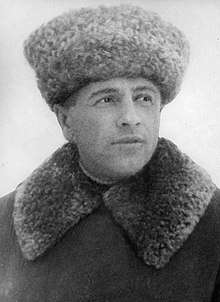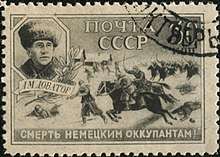Lev Dovator
Lev Mikhaylovich Dovator (20 February [O.S. 7 February] 1903 – 19 December 1941[1]) was a famous Soviet Jewish major-general who was killed in action during World War II and posthumously awarded the title of Hero of the Soviet Union.
Lev Dovator | |
|---|---|
 | |
| Native name | Леў Міхайлавіч Даватар Лев Михайлович Доватор |
| Born | 20 February [O.S. 7 February] 1903 Khotino, Vitebsk Governorate, Russian Empire |
| Died | 19 December 1941 (aged 38) near Palashkino, Ruzsky District, Moscow Oblast, Soviet Union |
| Buried | |
| Allegiance | |
| Service/ | Red Army |
| Years of service | 1924–1941 |
| Rank | Major general |
| Commands held | 3rd Cavalry Corps 2nd Guards Cavalry Corps |
| Battles/wars | World War II |
| Awards | Hero of the Soviet Union |

Life
Born in 1903, Dovator came from a Belarusian Jewish peasant family.[2][3] In 1922, he was elected to be Secretery of Komsomol Committiee of Khotino village. He joined the Red Army in 1924 and went on to become an officer after graduating from cavalry school and a military academy.[4] In 1926 he attended Borisoglebsk-Leningrad Cavalry Commanders School, graduating in 1929 to become a platoon commander in the 27th Cavalry regiment, 5th Cavalry Division. In October 1933, he was posted with the 1st Cavalry Regiment, 1st Cavalry Division, as a commissar. From May 1935 to May 1936, Colonel Dovator was commissar of the Independent Reconnaissance Battalion of the 93rd Rifle Division. He attended Frunze Military Academy in 1939, and during the early months of the war, Dovator was with the Western Front Headquarters. (Harrel,2019) At the outbreak of the Second World War he was a Colonel in charge of a brigade of Cossack cavalry.[5]
Operation Barbarossa
At the start of the German invasion of the Soviet Union, he was posted as Chief of Staff of the Red Army's 36th Cavalry Division. In July 1941, he won the Order of the Red Banner for bravery in the defense battles of at the Solovyo crossing of the Dnepr. Colonel Dovator conducted a successful fighting withdrawal, heroically crossing bridge over Dnepr River just before the Germans captured it. In August 1941 he was given command of cavalry group consisting of 50th and 53rd Cavalry Divisions. General Lev Dovator's 50th and 53rd Cavalry divisions were raised exclusively from Kuban Cossacks. Despite his Jewish heritage, unique with the Cossacks, they accepted Dovator as one of their own and considered him a great leader, superb horseman, and master of sabre. (Harrel.2019)
By mid-August, German troops reached the Mezha River. On August 13, Dovator received orders to raid the German rear and disrupt preparations for their next advance. Out of his two divisions of 4,500 men he took only 3,000 Cossacks. The group was concentrated in the vicinity of Pozhano, Formino, and Budnits. By mid-August, the cavalry group was assembled in swampy and forested region 20km/12miiles east of Zharkovskii, well behind and beyond the 30th Army's right flank. For a week, Dovator's Cossacks repeatedly probed the German defenses, seeking to infiltrate. The Cavalry Group pressed its advance into the German rear in a dispersed formation, traveling along cart roads and forest trails. (Harrel. 2019) Thanks to the excellent reconnaissance cavalry 10 days saturated the troops smashed the German rear. During this time they killed more than 2,500 troops of the Wehrmacht, 200 vehicles, and 7 tanks. There were also the famous artists of the Moscow circus from the team of Mikhail Tuganov who served bravely in his unit. They were able to shoot standing on the back of a galloping horse or, on the contrary, the firing, diving under the belly of a horse, which also influenced the development among Germans of the myth of the wild Russian.
The formation created an illusion that the riding force is much larger than 3,000 sabres, which had a great psychological effect on the Germans. The squadrons unexpectedly materialized from dense forests to cut communication wires, attack supply convoys and isolate German garrisons, only to vanish back into the forests. Once liberated, the villagers reported that they had heard from the Germans that 100,000 Cossacks had broken through the Geran lines. Dovator' deception was obviously working. (Harrel.2019) He soon became the commander of a cavalry group, and in August–September 1941 this cavalry group executed the most daring raid through the rear areas of the German army in the area of Smolensk. Dovator's famous raid in early 1941 was conducted with only 3000 sabres and sixty-five machine guns carried on packhorses. (Harrel, 2019) The Germans after the raid appointed the award in 100 thousand marks for his head. 11 September 1941 he was promoted to Major General for this action.[6]
Battle of Moscow
On November 20th, his unit become the 3rd Cavalry Corp in the short time due to its enormous success in battlefield on 27th of November it was renamed 2nd Guards Cavalry Corp. During the Battle of Moscow, Dovator was the commander of 2nd Guards Cavalry Corps, which fended off the enemy advance at Volokolamsk.[7]
He was killed in an offensive action on 19 December 1941 near the outskirts of Ruza. He was reportedly cut down by machine-gun fire while crawling towards a forward position to get a better look near the village of Palashkino.
Dovator was posthumously given the title Hero of the Soviet Union[8] two days afterwards, as well as the Order of Lenin. He was replaced in command by Major General Issa Pliyev.[9] Lev Dovator is buried alongside Ivan Panfilov as they heroicly fought toghether to stop the German 9th Army from reaching Moscow.
References
- Alexander Werth, Russia at War (1964), Carroll & Graf, page 254.
- Агитатор армии и флота (in Russian). Moscow: Красная звезда. 1991. p. 26. OCLC 5332056.
- Навечно в сердце народном. К 30-летию победы над фашистской Германией (in Russian). Minsk: Белорусская советская энциклопедия. 1975. p. 121. OCLC 30335590.
- Khandazhanov, Sodnom (1980). Мои однополчане (in Russian). Ulan-Ude: Buriat. kn. izd-vo. p. 17. OCLC 500181079.
- Soviet Calendar 1917-1947: December
- Soviet Calendar 1917-1947 (CCCP production)
- Samsonov, Aleksandr (1990). Вторая Мировая война, 1939-1945: очерк важнейших событий (in Russian). Moscow: Nauka. p. 217. ISBN 5020085243. OCLC 25788005.
- Zhukov, Georgy (1974). Marshal of Victory, Volume II. Pen and Sword Books Ltd. p. 50. ISBN 9781781592915.
- Braithwaite, Rodric (December 9, 2010). Moscow 1941: A City & Its People at War. Profile Books. ISBN 1847650627.
- Harrel, John (2019). Soviet Cavalry Operations During The Second World War: The Genesis Of The Operational Manoeuvre Group. Pen & Sword Military.
External links
- Biography of Major-General Lev Mikhailovich Dovator at www.generals.dk
- Lev Dovator at Find a Grave